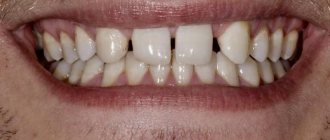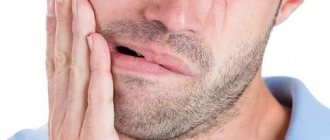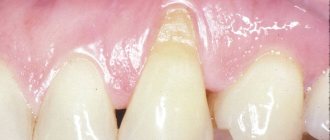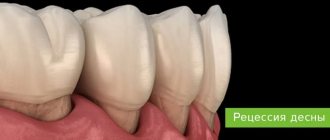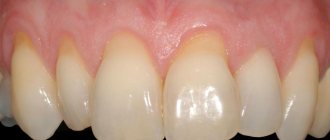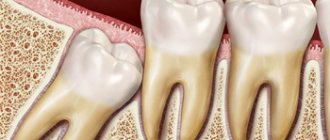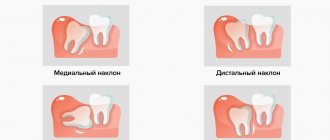The bite is the relationship between the teeth of the upper and lower jaws when they are closed. Depending on the nature of the closure, the types of bite are distinguished. It can be right and wrong. Doctors also talk about physiological and pathological occlusion. For example, if the jaw is too forward, so that individual teeth protrude and stick out, then correction is necessary.
An orthodontist deals with bite problems in children and adults. You can determine a malocclusion yourself. In front of the mirror, you can notice that the closure of the teeth is not ideal. In addition to aesthetic defects, malocclusion is also fraught with disturbances in facial expressions and speech. Facial asymmetry is often observed, which causes psychological problems to arise.
What is correct (physiological) bite
Physiological types of occlusion are characterized by the correct closure (occlusion) of the teeth. There should be no gaps, gaps or bony protrusions between the teeth. Correct occlusion is established only when all teeth are located along the center line.
Correct types of occlusion do not involve disturbances in chewing function. The upper jaw is shaped like a semi-oval, and the lower jaw resembles a parabola.
A physiological bite gives a person the following advantages:
- aesthetic smile;
- correct articulation and clear speech;
- correct primary processing of food (chewing).
Varieties
| View | Short description |
| Orthognathic (1) | The bite is perfect, there are no gaps when both dentitions are closed, the incisors are straight |
| Straight (2) | The upper teeth are not able to overlap the lower row, but are closed only by the cutting edges. May have a negative character, fraught with abrasion of the front dental elements through an increase in the load on their cutting part |
| Progenic (3) | This bite can be considered as incorrect, since it is characterized by a slight forward movement of the lower jaw |
| Biprognathic (4) | The rows have an inclination towards the lips, which is noticeable when viewing the jaw from the side |
| Opisthognathic | Visible inclined inwards the oral cavity. In this case, the front teeth look almost perfectly straight |
Types of human bite
Attention! All types of correct dental closure can provide an aesthetic appearance of a smile and healthy functioning of the jaws, but based on statistics, there is an average of only 10-20% of the population with ideal teeth alignment.
Perfect closure (opistognathic appearance)
Correct bite: how to understand
To evaluate your bite, you need to see a dentist. The doctor will do this quickly and accurately. If you want to do this yourself, you should know that a correct bite satisfies the following requirements:
- When the upper jaw contacts the lower jaw, an ideal contact is formed between the opposing teeth (upper and lower).
- The central front teeth (incisors) are positioned symmetrically. That is, they are equidistant from an imaginary line running down the center of the face.
- The dentition should be smooth, without gaps or crevices.
- It is considered normal if, when closed, the upper teeth cover the lower teeth by about a third.
Important! The criteria described above, which can be used to determine the bite, are for informational purposes only. Only a doctor determines the types of bite and makes a diagnosis.
Which braces system should you choose?
The least expensive and most proven option is metal braces. Plastic ones are also inexpensive, but they are inferior in strength to metal ones. If aesthetics are more important to you, opt for more expensive ceramic, sapphire or lingual braces.
As for “internal” braces, their only difference from all others is the aesthetic factor. One of the inconveniences is that such braces change the diction, they are more difficult to care for and they are not suitable for everyone. You need to have an almost perfect bite: just “uneven teeth.”
Correct bite: types
There is no ideal physiological bite. There are only types of occlusion that are close to perfect and do not require orthodontic or surgical intervention. Let's consider the main physiological types of occlusion.
Orthognathic occlusion
Orthognathic is considered the most correct bite, and is found in 90% of people with physiological occlusion. Orthognathic bite can be determined at home. Permanent teeth should fit tightly together. In this case, the upper incisors slightly cover the lower ones.
Straight bite
In a straight bite, the upper and lower jaws are the same size. At the same time, both the incisors and chewing teeth close. Individuals with a straight bite can boast a very beautiful smile.
However, such a closure is not without its drawbacks. Direct bite is dangerous due to premature destruction of hard dental tissues. This is due to the increased load on the teeth when closing. In this case, the enamel wears off faster, cracks and chips form.
Biprognathic bite
Biprognathic types of occlusion occur in children and adolescents who have the habit of thumb sucking. Also, these types of closure can develop in a baby if it is too late to wean him off the pacifier.
With this type of bite, the incisors bend slightly forward. At the same time, they come into contact, and for this reason such a bite is considered physiological.
Progenic bite
This is a normal option provided that the teeth develop normally. A feature of a progenic bite is that the lower front teeth are slightly pushed forward.
Self-determination
To determine the correct closure of the jaw arches, it is not necessary to visit an orthodontist or dentist. You can independently conduct a visual inspection, relying on the established parameters for correct occlusion.
Important! The type of bite and the severity of its violation are diagnosed exclusively by a specialist.
The algorithm of actions is as follows: closing your mouth, swallow saliva, close your teeth and fix their position. Next, spread your lips, look in the mirror and evaluate the relative position of the jaws.
If there are no problems with the bite (i.e. it is physiologically correct), the following picture is visible:
- There are no spaces (gaps) between the teeth.
- All units have the correct location and stand on the same line.
- The maxillary elements are in close contact with the mandibular elements.
- The lower incisors overlap the upper ones by 1/3 of the height of the crown parts (i.e., the palatal surface of the maxillary elements should be in contact with the cutting edges of the mandibular elements).
- The midline runs along the central incisors of both jaws.
- The palatine tubercles of all upper elements are located on the chewing grooves of the lower ones.
- Symmetry of the lower facial circumference.
- The upper jaw arch should be semi-oval in shape and have larger parameters than the lower one (its shape should resemble a parabola).
Important! Any doubt or detection of one or several inconsistencies at once is a reason to visit the orthodontist.
You should also contact a specialist if there is a large concentration of soft plaque on individual units, the inability to clearly pronounce individual sounds, or prolonged bleeding of gum tissue is observed.
Signs of biprognathic occlusion, characteristics, symptoms and correction.
This publication provides detailed information about straight bite in humans.
Here https://orto-info.ru/zubocheliustnye-anomalii/okklyuzii/chto-takoe-sindrom-kostena.html we will look at the symptoms and treatment tactics for Kosten syndrome.
Malocclusion: causes
Malocclusions are formed for a number of reasons, including:
- Hereditary factors . One of the leading causes of abnormal bite is genetics. The size and shape of the jaw are determined by genes received from the mother and father. Pathologies such as too narrow a jaw, cleft bite, misaligned dentition and other disorders are often dictated by hereditary factors.
- Nutrition . Malocclusion is considered one of the problems of modern civilization. In particular, we are talking about a situation where the lower jaw is underdeveloped. This is due to the abundance of liquid nutrition in childhood, which is why the lower jaw does not work fully.
- Mother's illnesses during pregnancy . Some abnormal types of bite occur due to maternal illness, especially in the first trimester of pregnancy.
- Wrong selection of pacifiers . An incorrect bite can develop if the nipples are not selected correctly. It is important that the baby makes an effort to obtain milk. Otherwise, underdevelopment of the lower jaw occurs.
- Bad habits in childhood . For example, thumb sucking and excessive use of pacifiers. Sleeping position also affects your bite. Often a malocclusion is formed when the head is thrown back.
- Diseases of the ENT organs . It is important to treat ear, nose and throat pathologies in a timely manner. With such diseases, the child is often forced to breathe through the mouth. Therefore, diseases such as sinusitis, rhinitis, adenoids and deformation of the nasal septum require adequate and competent treatment.
- Physical development disorder . In particular, we are talking about diseases affecting the growth and development of bones.
Bite formation in children
At the stage of bite formation in children, there are three most important periods:
- The milk bite begins to form at six months of age and continues until 3 years of age. This is the initial stage during which the foundation for the formation of a permanent bite is laid.
- The change to a permanent dentition lasts up to 9 years. During this period, the jaws actively develop and a permanent bite begins to form. During this period, when the dentition consists of baby and permanent teeth, children often develop malocclusions. Common causes are a violation of the pairing of teeth erupting with an unequal degree of development of the jaw sections.
- The formation of a permanent bite occurs from 12 to 15 years. The replacement of baby teeth ends, permanent teeth complete their growth and are installed in their permanent places.
Prevention of malocclusion in childhood is very important, as it determines whether the child will have problems in the future. Adults should monitor the eruption of permanent teeth in children and visit an orthodontist with the child for timely detection of anomalies and bite correction.
How to determine a pathological bite
Pathological types of bite are determined by the doctor. If you suspect a problem in yourself or your child, you should contact the dentist. Here are some features of pathological bites that you need to pay attention to:
- The teeth do not close tightly. Gaps and gaps form between the upper and lower teeth.
- There is partial or complete lack of contact between opposing teeth (incisors and/or chewing molars) (there is a short gap in the horizontal plane).
- The upper jaw is noticeably smaller than the lower jaw or vice versa.
- Dental crowding or occlusion, where teeth overlap each other.
- The presence of a diastema - a noticeable gap between the incisors.
- Change in appearance. For example, the lower jaw is shortened and the lips are turned inward.
- Exposure of tooth roots and other defects of hard dental tissues. For example, an indirect sign of malocclusion is poor enamel and wear of the cutting edges.
Need for correction
If even minor signs of malocclusion are observed, a visit to the orthodontist should not be neglected. In the absence of specific treatment, the consequences of a pathological bite are serious.
So, in addition to an aesthetic change in appearance, a defect that persists for a long time can lead to other problems:
- Periodontal diseases resulting in premature tooth loss.
- Violation of the functionality of the TMJ.
- Regular injury to the soft tissues of the oral cavity and a high risk of inflammation, bleeding, and erosion.
- Psychological problems.
- Deterioration in the quality of oral hygiene.
- Decreased chewing activity.
- Deterioration in the passage of air through the respiratory lumen due to its narrowing.
- Uneven distribution of chewing load.
- Rapid abrasion of enamel.
- Changing diction.
- The occurrence of diseases of the digestive system.
- Deterioration in general health.
- Impaired blood supply.
There is an opinion that correction of bite defects should be done only in childhood and adolescence. But it is not so. Yes, doctors actually achieve the best correction results with minimal discomfort if treatment is started in the age range from 8 to 15 years. But this does not mean at all that it will not be possible to correct the bite even in adulthood.
Modern techniques in the field of orthodontics allow doctors to confidently state that high-quality occlusion correction can be performed on any patient, regardless of his age and existing concomitant diseases.
In this case, you just need to take into account one important fact - the correction of pathology in children is much faster and more comfortable than in adults.
Malocclusion: types
Like physiological types of occlusion, pathological ones also come in different types. Below is a classification of malocclusions.
Distal bite
This is a type of malocclusion in which the upper jaw is highly developed compared to the lower jaw. For this reason, the upper teeth move noticeably forward.
Mesial bite
In this case, the lower jaw protrudes noticeably forward compared to the upper jaw. Sometimes there is a retraction of the upper lip. Often, with mesial occlusion, the functioning of the temporomandibular joint is impaired.
Crossbite
It is observed when the jaw shifts to the right or left. In this case, 1-2 teeth are in the wrong position.
Deep bite
In this case, the upper teeth cover the lower teeth by more than half. With a deep bite, a speech defect is observed, and the oral mucosa is also injured.
Open bite
There is a large gap between the dentition during occlusion. This is due to the fact that some teeth cannot close when closed. Open bites often occur when a child sucks a finger or a pacifier for a long time.
Position of individual teeth
What is most striking is the uneven position of individual teeth. They can be tilted, rotated, pushed forward or pushed back relative to others.
Crowding of the upper teeth
Protrusion of teeth (excessive tilting)
Rotation of teeth (they are rotated along their axis)
If the position of the teeth is disturbed, the bite as a whole may be correct, but this is rare. Since all teeth strive to form contact, if some are deviated, others will deviate as well. Therefore, treatment is almost always required not only to straighten teeth, but also to correct the bite.
Bite in the absence of teeth
If the patient has no teeth left, then there is no guarantee that prosthetics will be able to achieve an anatomically correct jaw. In this case, much depends on the initial positions (what the bite was like before losing teeth). If the upper and lower jaws are positioned relative to each other within normal limits, then the bite can be straightened with minor corrections. If the patient had problems with the jaw bones, then a deeper correction is required.
In the absence of teeth, the bite is determined using wax rollers. This creates an imitation of the dentition, which allows for standard changes. For this purpose, special plates and a curved, arc ruler are used. After all measurements and preparatory procedures have been carried out, a plaster and then a regular prosthesis is initially created in the dental laboratory.
Important: bite after wisdom tooth removal . Wisdom teeth were important for ancient people, but now there is no need for them. If wisdom teeth do not cause problems for a person, then doctors recommend not touching them. However, in cases where an adult wants to correct an incorrect bite, wisdom teeth can help with this. Thus, correction of the bite in adults is possible after the removal of wisdom teeth. The space formed after their removal allows the dentition to take an anatomically correct position.
How to care for braces?
Caring for braces requires care and discipline. We talked about it in more detail in a separate article. After installing braces, the doctor will tell you how to live now. We will indicate the most important things.
- Always have brushes and a single-tuft brush on hand.
- Add a waterpik to your arsenal.
- If you are not sure that you have brushed your teeth well, use an indicator tablet. After brushing your teeth, the tablet must be dissolved in your mouth. The areas where plaque remains will turn blue. These areas need to be cleaned again.
- Avoid very hot and very cold drinks. Braces, like enamel, do not like sudden temperature changes.
- To prevent braces from coming off, follow a diet. Eliminate nuts, toffees, seeds, and flour from your diet. Apples and other hard fruits should not be bitten off, but cut into small pieces and placed on the chewing teeth.
Malocclusion: consequences
Malocclusion is a problem that should not be underestimated. Over time, malocclusion can lead to the following consequences:
- Premature tooth loss . This is due to two factors. Firstly, an incorrect bite increases the load on the teeth. This threatens the appearance of cracks and chips. In addition, an abnormal bite increases the risk of developing periodontal disease. This leads to accelerated tooth decay.
- Damage to the gums . With an incorrect bite, gum health deteriorates. They become sensitive to temperature, chemical and physical factors. In some cases, this leads to the formation of ulcers on the gums.
- Pathologies of the temporomandibular joints . The most common symptoms are a clicking sound when chewing, which should not normally be present. Then pain occurs, and the function of the joint deteriorates even more.
- Diseases of the digestive system . Well-chewed food is one of the conditions for normal functioning of the gastrointestinal tract. If the bite is broken, then relatively large pieces of food enter the stomach. Due to poor initial processing of food in the oral cavity, over time a person develops eating disorders.
- Psychological problems . Pathological types of bite often worsen a person’s appearance. This is how low self-esteem is formed. A person becomes overly modest, fearful and unsure of himself. Sometimes, in order to improve the situation, in addition to dental treatment, the help of a psychologist is also required.
Reasons for the development of anomalies
Orthodontists have not yet established the exact reason that leads to distortion in the process of occlusion formation in children and its change in adults. Only a few provoking factors have been identified.
The causes of pathologies of the dentofacial apparatus in children may be:
- Problems with intrauterine formation and further development of the fetus.
- Facial injuries received at birth.
- Heredity.
- Artificial feeding with an incorrectly selected nipple.
- Regular breathing of the child through the mouth.
- Bad habits, namely the desire to constantly keep something in the mouth (gnaw), prolonged use of a pacifier, biting the cheeks.
- Improperly organized nutrition with a predominance of soft food low in macro and microelements and vitamins.
- Severe injury to teeth or jaws.
- Chronic pathologies (metabolic disorders, respiratory diseases).
- Incorrect position in sleep.
- Rickets.
- Early removal (loss) of teeth.
In adults, a change from a correct bite to a pathological one can occur for the following reasons:
- Due to untimely restoration of prematurely lost teeth.
- Due to severe trauma to the face and dentofacial apparatus.
- After unprofessional prosthetics.
- Due to improper breathing, which developed against the background of ENT diseases.
- As a result of the progression of periodontal tissue diseases, which cause loosening and early tooth loss.
- Due to insufficient oral hygiene.
- Due to prolonged hypertonicity of the masticatory muscles resulting from stress.
Important! The absolute pathological significance of each of the listed factors on occlusion has not been established. The presence of the same cause in people does not in all cases lead to the formation of an anomaly.
Treatment of malocclusion
Today, malocclusions are treated using various techniques. Most often, the curvature can be corrected with orthodontic methods, but in some cases surgical correction is necessary. Let's look at the most effective ways.
Orthodontic plates
These are removable hard plates that allow you to maintain the correct alignment of your teeth. Such structures consist of a plastic base and metal elements that hold the plate in the oral cavity.
Orthodontic plates are often used in pediatric dentistry. These products help develop the habit of breathing through the nose and also stop thumb sucking. In this case, the correct bite is formed due to the work of the muscular system. Depending on the tasks assigned, different types of plates are used. These are standard plates, plates with a visor, a flap or a bead. The plates are made from hypoallergenic materials. Those with baby teeth usually have soft plates installed. For permanent teeth, hard ones can be used.
Trainers
Another way to even out an uneven bite is to use trainers. These orthodontic structures are a two-jaw mouthguard made of silicone or polyurethane. Changing the bite with trainers occurs due to muscle work.
It is noteworthy that the result of such treatment persists even after the end of the course, because muscle memory is preserved. Trainers are successfully used for the following problems:
- open and deep bite types;
- mouth breathing;
- speech defects;
- crowded teeth;
- bad childhood habits (for example, thumb sucking);
- incorrect position of the lower jaw.
Treatment with trainers is carried out in 2 stages:
- First stage . It lasts 6 months and involves wearing soft trainers. This is necessary in order to activate the work of the chewing and facial muscles.
- Second phase . Soft trainers need to be replaced with hard ones. Such trainers directly affect the position of the dentition.
Advantages of trainers:
- affordable price;
- absence of unpleasant sensations;
- the ability to remove the structure while eating or talking.
Aligners
These are dense transparent trays for straightening teeth. Aligners are made individually for each patient. As a rule, this is a series of designs, each of which is worn for a certain period of time, and then replaced by a new one. This is a kind of cascade correction method. The disadvantage of this treatment is the relatively high price.
Braces
One of the most effective orthodontic methods of bite correction is braces. These are special locks connected in an arc. For more successful treatment, braces are also equipped with special elastic bands (or pulls). With the help of elastic bands, it is possible to increase the pressure on the dentition that needs to be corrected.
Incorrect types of bite are treated with braces in several stages:
- Preparatory . At this stage, diagnostic measures and selection of a treatment regimen are carried out. Professional teeth cleaning, plaque and tartar removal are carried out. If the patient has any dental diseases, they are treated before installing braces. Then the braces are made.
- Installation . The patient gets braces. Vestibular braces are installed on the outside, and lingual braces on the inside. Fastening is carried out on an adhesive basis, so it is painless. It should be borne in mind that during the first week there may be pain, which can be relieved with painkillers.
- Retention . After the braces are removed, the patient needs to wear retainers for a while. This is necessary to consolidate the result. The duration of wearing retainers is determined by the doctor.
Contraindications to orthodontic treatment
In some cases, orthodontic treatment for malocclusion cannot be carried out.
Contraindications:
- mental illness;
- pathologies of the central nervous system;
- malignant tumors;
- severe diseases of internal organs.
There are also relative contraindications, in which orthodontic treatment is possible subject to certain conditions.
Relative contraindications:
- Periodontitis with mobility of teeth 2 degrees.
- Poor oral hygiene. If a teenager does not take care of dental hygiene, then wearing orthodontic structures (for example, braces) is contraindicated. This is due to the fact that in this case the teeth are quickly destroyed.
Surgery
Surgery is resorted to in cases where it is a malocclusion of the 3rd degree of complexity. In such cases, orthodontic techniques are ineffective. Such operations usually last several hours. After 2-3 weeks you can return to your normal life. A month later, the patient begins jaw development techniques (to be discussed with the doctor). In some cases, after surgery, the patient is prescribed braces.
Laser bite correction
A laser for correcting occlusion is used at different stages of correction. For example, after correcting a bite, teeth tend to move. For this reason, bone tissue experiences heavy loads, causing microtrauma and inflammation to occur. Laser therapy helps eliminate inflammation and promotes rapid healing.
Attention! The laser is not used as an independent method of bite correction. It is used as an auxiliary method for treating associated complications and processes.
Diagnostic measures
In a clinical setting, to identify defects in the structure of the dental system, as well as to determine the severity of the pathology and draw up a plan for its elimination, specialists conduct the following examinations:
- Visual inspection . The doctor assesses the presence and severity of signs of malocclusion, studies the characteristics of the face (the relationship of its parts, symmetry), the condition of the periodontium and enamel coating.
- Modeling. An accurate impression of the jaws is made, from which the relationship is determined and a diagnostic model is created to calculate the scope of the upcoming medical intervention.
- Electromyography is an examination that reveals imbalances in the work of the facial and masticatory muscle groups.
- An orthopantomogram is a panoramic image that gives a complete picture of the condition of the entire oral cavity, namely the correct structure of the jaw arches, sinuses, and joints.
- Teleroentgenogram is a photograph of the skull taken in frontal and lateral projection.
Allows you to clarify the characteristics of the closure of the jaw arches, find out their parameters, evaluate the correct location of the dental elements, and also determine the angle of inclination or the degree of displacement (rotation relative to the axis). - An occlusiogram is a technique that allows you to analyze the occlusal contacts of all units on both jaws.
- Symmetroscopy is an examination that gives an idea of the location of the teeth in the transverse and sagittal direction.
Important! The listed diagnostic measures help the orthodontist to correctly analyze the situation and take adequate measures.
FAQ
Is it possible to correct an overbite without braces?
Yes, you can, but under certain conditions determined by the doctor. Malocclusions can be treated using orthodontic plates, trainers or aligners.
Is it possible to correct an overbite at home?
It is impossible to correct a crooked bite at home. There are exercises to strengthen the muscular system, but they are ineffective and are used only in addition to the main therapy.
How long do you need to wear braces for an overbite?
Depends on the degree of damage and the age of the patient. The minimum wearing period is 6 months. In some cases, braces are worn for up to 3 years.
Is it possible to get veneers if you have an incorrect bite?
It is possible, but only with minor deviations from the norm. Otherwise, orthodontic treatment is initially carried out, and only after that is it permissible to install veneers.
How much does it cost to correct a bite?
It all depends on the amount of work. First of all, you need to undergo a diagnosis. Mild degrees of malocclusion respond well to treatment with removable orthodontic structures. In such cases the price will be low.
